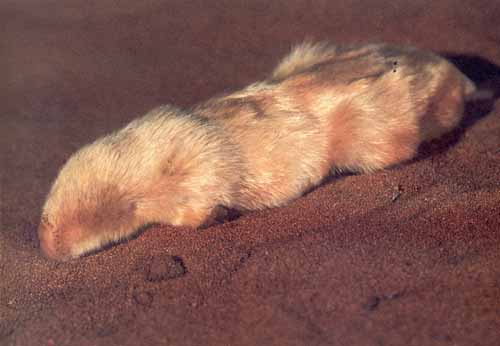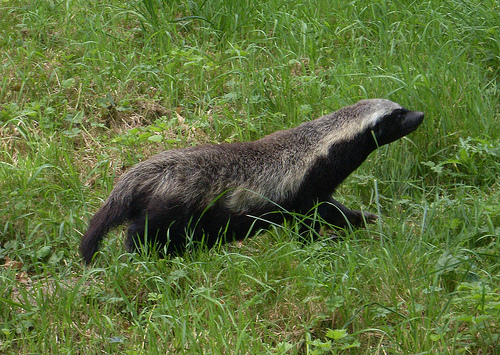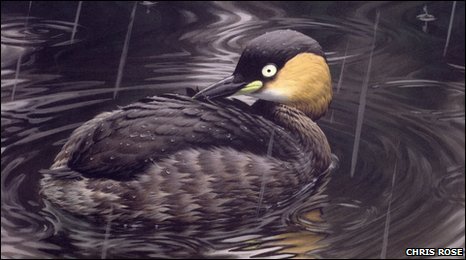The Itjaritjari: A mole that isn't
These little endearing creatures are found in the deserts of South Australia. They have fabulous golden fur and are pretty much blind.
They are marsupials and swim in the sand. They burrow in the sand looking for small animals and making vibrating sounds all the while.
Here are a couple of cool videos on this lil' guy!
blog comments powered by Disqus
The Formidably Funny Honey Badger
Talk about being pugnacious! This little lad lives in the Kalahari and will take on anyone who he can eat or steal a meal away from.
Why the name honey badger, one may ask? Nothing sweet or cuddly about this chap! He is so called because he can take on the african honey bee and just destroy their hives. Apparently, their stings don't bother him terribly.
blog comments powered by Disqus
SAD FACT: Extinction is FOREVER!
It has just come to light that a rarely seen, rarely photographed bird has finally vanished in the obscurity of time. Well, extinctions happen, one might say! It is part of nature "red in tooth and claw". True, but the the pace of this extinction that is going on around us is faster even than the one experienced during the dinosaur era.
We have lost many animals to senseless slaughter by humans either directly, or through the destruction of an ecosystem. Let us go through a list of large recent extinctions.
Thylacine - Tasmanian Tiger There was a bounty on this animal paid by the Australian government because it came in the way of sheep farming. The last video seen is this one.
California Grizzly Bear There is a grizzly on the california flag. There is Big Bear Lake in the mountains near L.A. but the grizzly bear was hunted to extinction in California as early as 1907!
Caspian Tiger The extinction of the Caspian tiger can also be attributed to the large scale extermination of this animal by the Russian administration to reclaim land in the beginning of the 20th century.
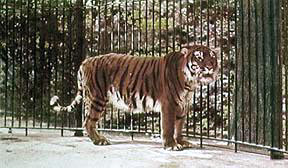
Oh! the shame of it all. We need to be more mindful of our environment. Let's get out of drilling oil all together. The cost is too high for our children to pay.
blog comments powered by Disqus
Red panda-mania this Christmas at Wellington Zoo!
There was an extra present delivered to Wellington Zoo on Christmas Eve in the shape of a newborn red panda cub. However Zoo visitors will have to wait a little while to see the newest arrival, as the cub will spend its first three months mostly inside the nest box under the close protection of its 11 year-old mother Amy.
Keepers at the Zoo are currently keeping their distance from the parent and cub, limiting contact time to simple daily checks to allow them to bond. Amy's breeding partner Ishah is also staying clear during this formative stage -- which is natural behavior for red pandas -- meaning visitors will still be able to spot him around the enclosure.
"Breeding, for red pandas is a very precise art, so we are all really happy that Amy has been able to deliver another cub", Paul Horton, Team Leader of the Carnivore Team at Wellington Zoo said.
"We've thought since late July that she may be pregnant, so there was there was understandable excitement on Christmas Eve when we found she had given birth in her nest box." Over the years it has become quite common for the Zoo to receive Christmas gifts in the form of red panda cubs. This is because these animals have a very exact breeding season of only one to two weeks each winter.
"We won't know the panda's sex for another couple of months yet, but if it turns out anything like its sibling Sir Ed we know we have some eventful times ahead of us! At the moment however we're just trying to give mother and cub as much space as possible and letting nature take its course."
Wellington Zoo has kept and successfully bred red pandas since 1996. The oldest pair of pandas currently in residence, Jay and Reka, has successfully parented four cubs at the Zoo over the years.
Wild red pandas are most commonly found in the temperate forests of the Himalayas, which stretch west from Nepal across into China. As they are highly secretive animals it is difficult to know exact population numbers, but they have recently been listed as vulnerable in the latest IUCN Red List of Threatened Species.
Wellington Zoo's red pandas are proudly supported by Classic Hits Wellington.
The mother Red panda is pictured here on the right.
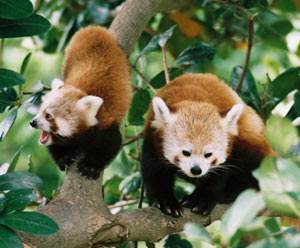
Extinction is forever!
Jeff Corvin talks about the wildlife that is vanishing right before our very eyes. It is quite disturbing to realize that whole ecosystems are being torn apart like just so much cobweb.
Visit msnbc.com for Breaking News, World News, and News about the Economy
Right Whales at the wrong place!
We have been hunting these gentle giants for millenia to the point of extinction for some, and high endangerment for others. A team of scientists from Oregon State University and the National Oceanic and Atmospheric Administration has spotted right whales in the north atlantic where they were supposed to be extinct.
The discovery is particularly important because it is in an area that may be opened to shipping if the melting of polar ice continues, as expected. The scientists are unsure of exactly how many whales were in the region, which is off the southern tip of Greenland and site of an important 19th-century whaling area called Cape Farewell Ground. But they recorded more than 2,000 right whale vocalizations in the region from July through December of 2007.
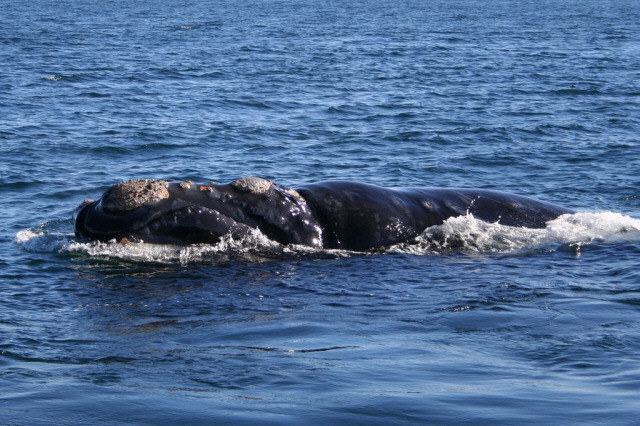
Only two right whales have been sighted in the last 50 years at Cape Farewell Ground, where they had been hunted to near extinction prior to the adoption of protective measures, said an OSU release.
Our great great great great grand aunt!
So we found our great great great great grand aunt. Ida, she is named after Dr. Hurum's daughter. This is a huge find for all those primate lovers out there because this ancestor of the monkeys and apes seems to be one of the most complete fossil specimens( only parts of of one of her legs are missing) of early monkey-lemur branch that looks more like an monkey and less like a lemur. Amazingly this find was first seen by Dr. Hurum at a bar in hamburg! That too, was just a few pictures of lil' Ida that a fossil dealer handed to him. The good doctor then had to come up with a million bucks to buy her based on the hunch that she was a true blue ancient monkey.
Ida is one of the remarkable fossil finds from the Messel pit in Germany. Scientists know that Ida is a female and think that she lived 47 million years ago, in a rain forest which had over 300 specific of plants and animals. Many of the plants that grew in the Messel rain forest are only found in the tropics and subtropics today.
We also know that the old world monkey and new world monkey ancestors also split shortly,geologically speaking of course, after the time of Ida. Humans emerged only around 200,000 years ago. We belong to an illustrious line of apes that split with the Chimpanzee line around 3 million years ago.
Dr. Hurum and his group have been analysing and studying Ida for two years and have just come out with this great discovery. It is a testament to their thoroughness and research that this fossil has come to light in such a big way. Watch out for papers in journals and so forth.
Please don't blame the pig!
WE call swine flu. Does it necessarily have to do with swine?NO! The whole family suidae has had quite a contentious relationship with humans. This latest insult to the noble family is quite a low even by current standards.
If the virus has evolved to use the pig as a host, it is to the detriment of pigs everywhere. It's not a pigs fault that we desire their meat and so work closely with them. When birds became infected with bird flu, I don't recall such invective against all birds. When it is pigs, all bets are off.
Let's call the illness for what it really is: 2009 H1N1 flu. I know it is not catchy but it is at least not libelous. Let's all not sneeze in each others face and we will be alright!
